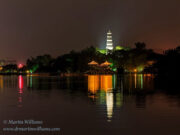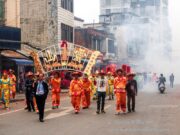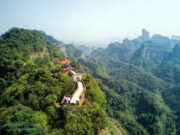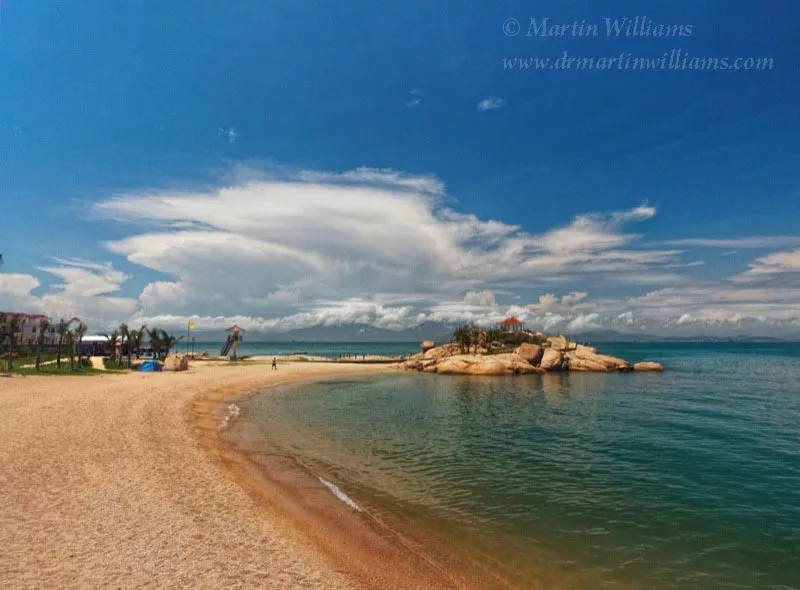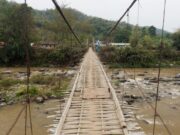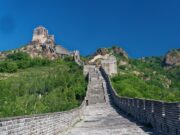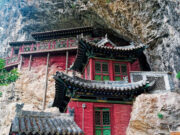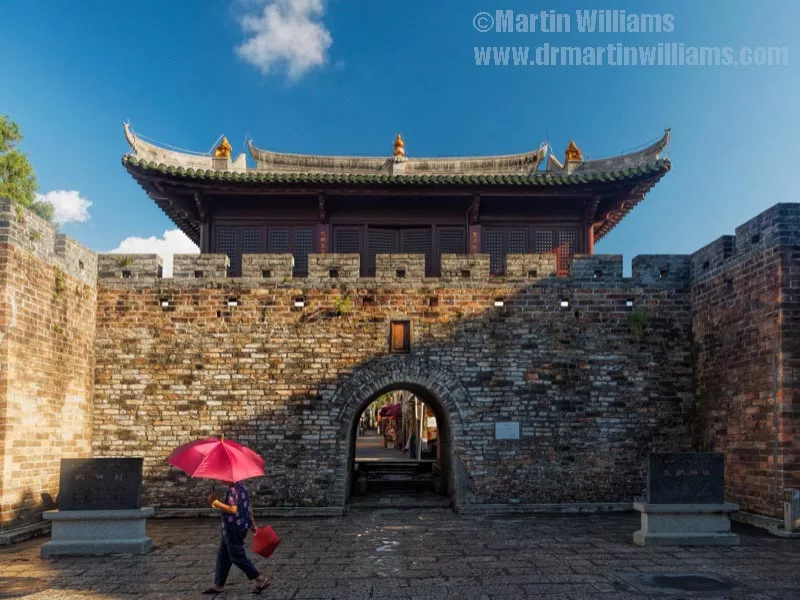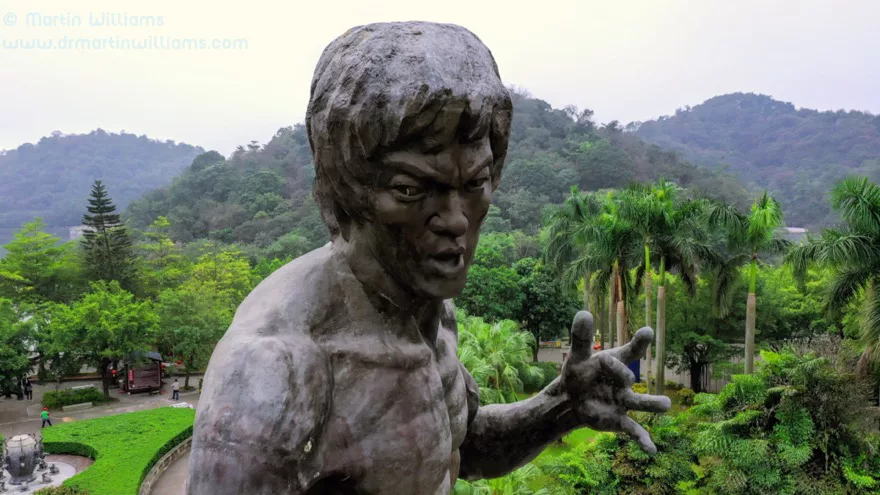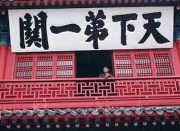Though I’ve read on travel websites that Weizhou Island in Guangxi province, southwest China, is volcanic, and seen maps showing a headland curling partway around the main bay, in the south, it’s only when on arriving at a hilltop vantage that I realise: this is no ordinary bay, but is instead the sea-filled main crater of the Weizhou volcano, with the calm waters belying its fiery origins.
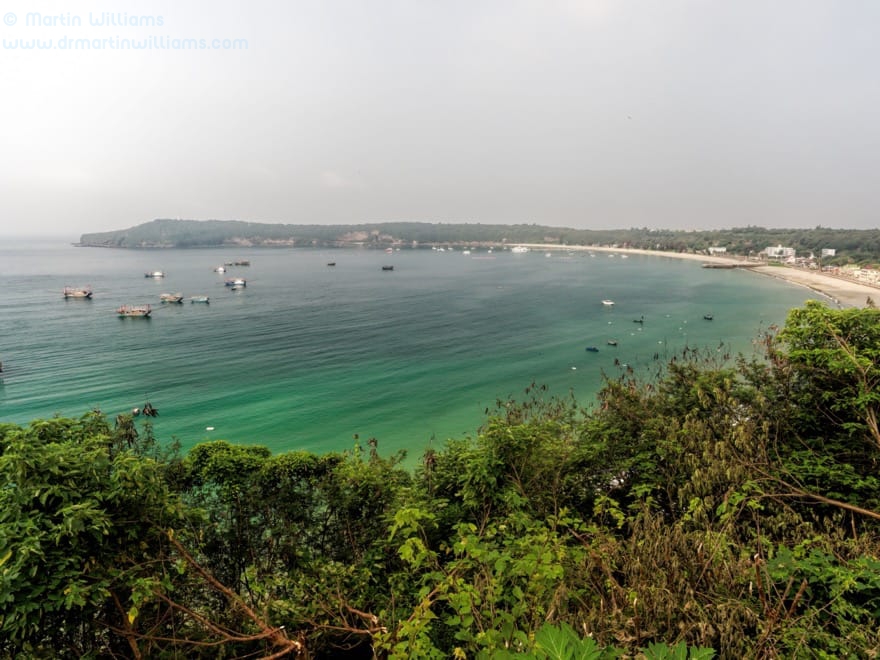
A little over half the bay is bounded by the crater rim, forming a steep slope up to 70 metres above the sea. Below the lookout point, there’s a village with a strip of restaurants above the tideline. Beside this is a beach backed by a wooded slope, beyond which lies the headland, the tip of which is 2km across the bay from us.
While the entire island is designated as a geopark, a visit to this southwest tip is a must for any Weizhou visitor with an interest in rocks and scenery. It’s called Crocodile Hill, and is protected by a park within the geopark. There’s an entrance at the top of the ridge, from where a flight of steps leads down to the shoreline.
The path leaves sparse woodland of spindly trees, arriving in a landscape akin to active volcanoes I’ve climbed in Indonesia, with a cliff of dark grey rock comprising layers of ash, looking freshly formed rather than weatherworn like the volcanic areas of Hong Kong. There are tour groups following the route, and I overhear a guide saying the last eruption was 7100 years ago. That’s the blink of an eye in geological time scales – compare 140 million years since Hong Kong’s volcanoes became extinct – so the Weizhou volcano is merely dormant, likely to someday erupt again.
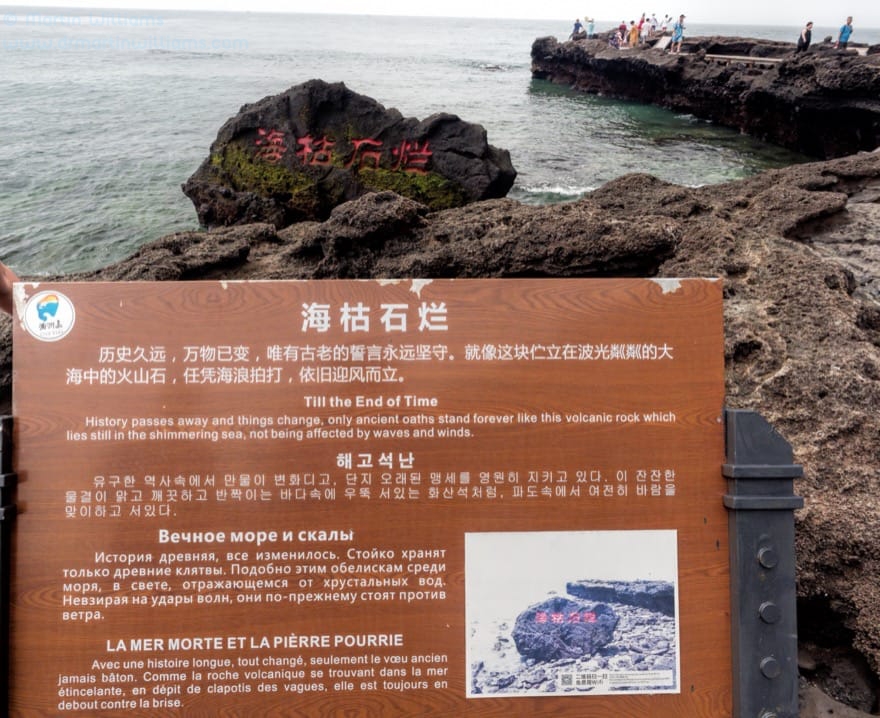
I briefly envisage a cataclysmic event, like at Santorini in Greece, which also has a sea-filled crater, and three thousand years ago caused a tsunami leading to the collapse of the Minoan civilisation. But information on the China Exploration website indicates that Weizhou’s days of major eruptions are long past, and the latest events have been localised blasts of ash and lava bombs. Still, I’m glad it remains dormant as we walk the coastal pathway, admiring the shoreline of rock hewn into features like a natural bridge and a “turtle” in a cave.
Weizhou’s green landscape and beaches
Beyond the southern rim of the bay, there’s a green, gently rolling landscape with a network of narrow roads and a smattering of hamlets. Cattle graze verdant pastures, near a wetland park that has an impressive new visitor centre but little wildlife apart from six Chinese pond herons.
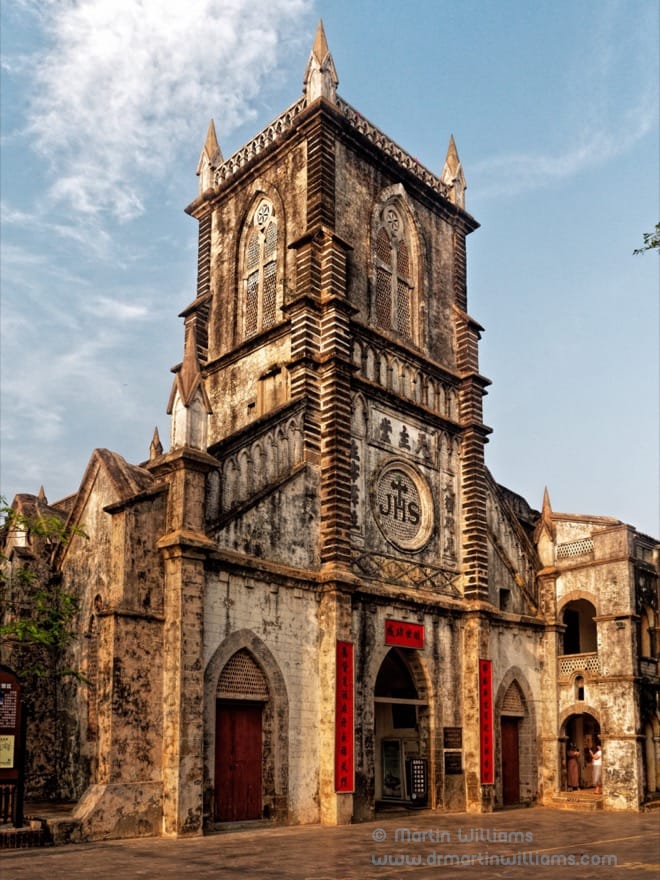
Though the hamlets are unremarkable, with low houses, some built of bricks fashioned from volcanic rock, Weizhou does have two fine churches, built by French missionaries around the middle of the 19th century. The largest and best known of these is the Gothic-style Catholic Cathedral. It’s tiny for a cathedral – rather like a stone-coloured, pint-sized cousin of St John’s Cathedral in Hong Kong – but has a quiet grandeur in its setting on Weizhou.
While the cathedral is beside a parking space, the other church is more secluded. Arriving on a steamy sunny day, my wife, son and I opt to take an electric vehicle shuttle service, rather than walk a few minutes from the car park. This church is dedicated to Notre Dame, the Virgin Mary, and to me recalls rural churches in England.
There are beaches around the coast of Weizhou, though waves rolling in across the turbulent Gulf of Tonkin can make swimming challenging and even dangerous, especially with tourists zooming about on jet skis. When the sea is calm, there is a chance to take boat rides in search of coral, and even to look for the Bryde’s whales – baleen whales growing to 15 metres long – that have recently been found to live around the island.
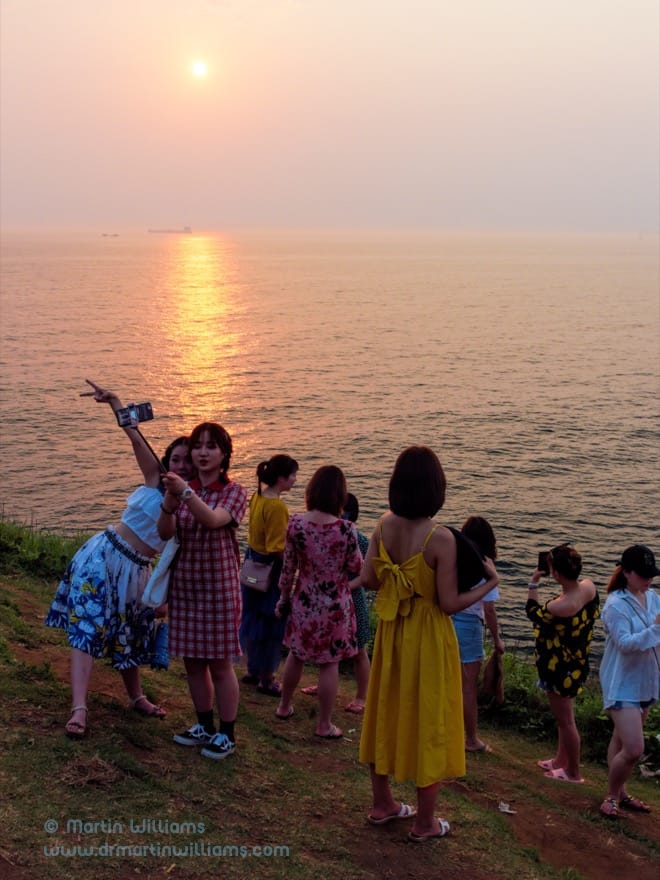
In late afternoons, a grassy headland in the northwest becomes a natural grandstand, attracting crowds who snap a multitude of photos as the sun sets over the sea.
Then, surely the best place to head is the village on the shore of the southern bay. This has a thriving seafood market, where tourists choose from an array of fish, squid, shellfish, crabs and more, then carry their purchases across to nearby restaurants that cook them for dinner. There are bars here, too; three or four of them host singers or live bands to attract punters, plus passers-by who pause on the narrow coastal road to briefly enjoy a free concert.
Beihai and the mystery of the empty and mostly empty apartment blocks
Weizhou Island lies 40 kilometres south of the city of Beihai, which occupies a chunky peninsula in coastal Guangxi province. It’s a good place to explore before or after heading to Weizhou, and blends coastal port with seaside resort, and Chinese enigma.
To me, that enigma centres on the mystery of how it’s possible to keep on building apartment blocks that few people or even no people actually live in. On the International Monetary Fund website, an article cites Beihai among Chinese cities that experienced a bursting housing bubble in the 1990s. Five years ago, the Daily Mail reported on “The City of the Dead’, a ghostly urban landscape with no residents to fill it” – describing a cluster of grand looking villas that remain a feature of Beihai today. It seems there’s an ongoing building spree, and the “hotel” where my wife, son and I stay turns out to be Airbnb style apartments in a complex built for thousands, most of whom may never arrive.
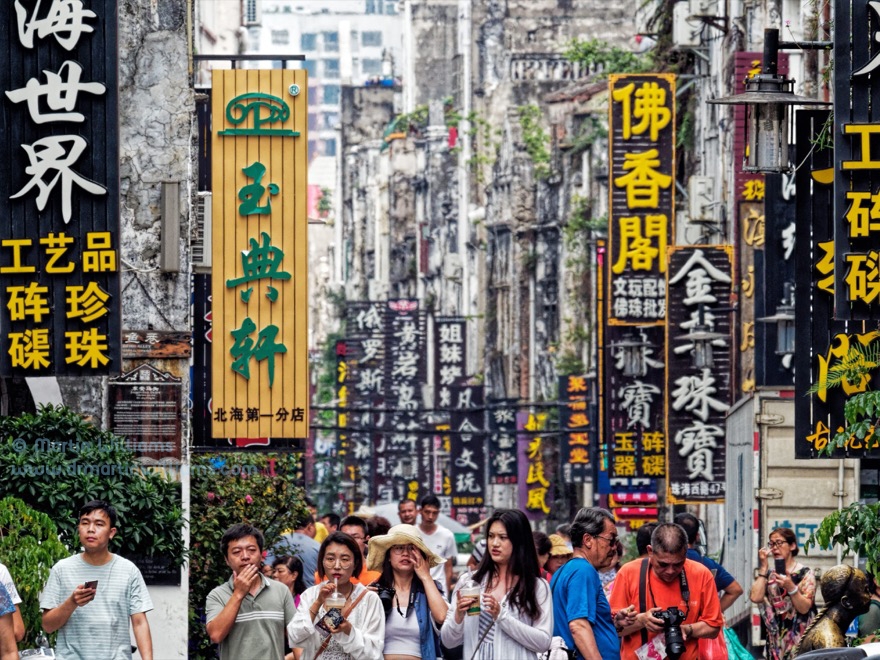
But there is history here, too, especially along Beihai Old Street. This is lined with three-storey buildings that may date from the late 19th century, and now host shops for tourists, with souvenirs, traditional snacks, and even hates and trinkets with styles hailing from the Cultural Revolution. A museum tells of western nations including Britain and France establishing presences here after Beihai became a treaty port in 1867. Some statues along the street portray characters from this treaty port era, including two European doctors who established a hospital here.
A theme park and the number one beach in China
Nowadays, international visitors to Beihai are scarce, though it is popular with domestic tourists from inland and northern provinces. A recently completed theme park targets them, particularly by focusing on Guangxi’s ethnic minority people, who here seem like the kind of savages roaming the wilder regions in Game of Thrones. Displays include an array of buffalo skulls, a jungle house, a “prison” that’s a small watery pit with bars above. Bare-chested, tattooed men jump on broken glass, breathe fire and, bizarrely, toss burning sticks in the air then catch them in their trousers.
At the southwest tip of the peninsula, there’s an outsize turtle statue on the tideline, standing almost as tall as a lady who pats it on the head head. At a nearby patch of sand, visitors cluster around fortune tellers, who use birds like tiny parrots to pull out cards used for their divinations. Perhaps it’s an ancient technique, yet they also accept payments via smartphones.
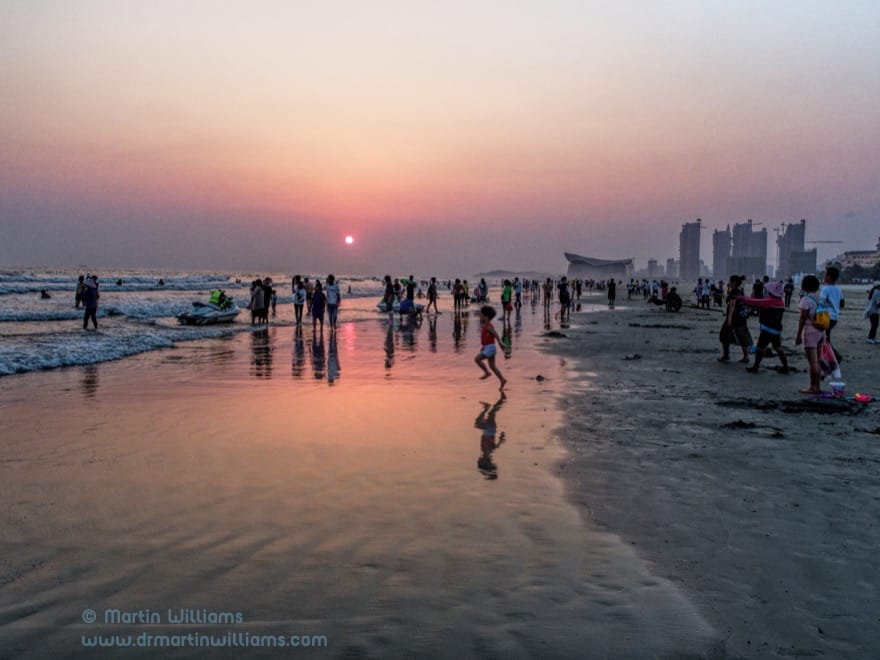
Also along the south coast, there’s Silver Beach, a stretch of sand over 20 kilometres long, which has been dubbed “the number one beach in China”. Articles such as a piece in the Daily Telegraph suggest it has lost some of its lustre, partly thanks to pollution by plastic, but it’s still worth a visit, perhaps requiring some effort to find the prettier areas.
Towards sunset one day, hundreds of people line the beach at an easily accessed spot by Beihai’s main harbour. With a motley array of restaurants and stores close by, it’s no tropical paradise. But there is another Beihai oddity nearby to the west, which may especially appeal to homesick Hong Kongers: a grandiose, modern building that looks a dead-ringer for the Convention and Exhibition Centre, in Wanchai.
If you go
You can head to Beihai by high speed rail from Hong Kong, changing at Guangzhou South station for a journey taking around 5.5 hours. The trip.com website is convenient for booking rail tickets you can collect at rail stations, as well as accommodation in Beihai and on Weizhou Island.
Weizhou Island is around two hours by ferry from Beihai, and you can buy tickets from travel agents in Beihai as well as at the piers in Beihai and on the island – maybe booking in advance as ferries may be packed. The ferries may roll uncomfortably, so consider taking a seasickness tablet before a ferry ride.
[Written for the South China Morning Post.]










































